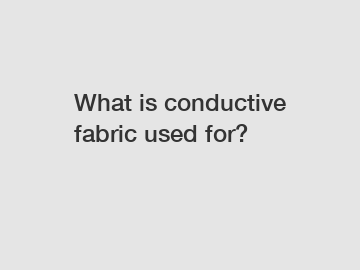What is conductive fabric used for?
Welcome to our blog, where we delve into the fascinating world of conductive fabric and the remarkable applications it offers. As technology continues to advance at an unprecedented rate, conductive fabric has emerged as a ground-breaking material that opens up endless possibilities for innovation in various industries. In this article, we will explore the diverse uses of conductive fabric and discuss how it is revolutionizing the way we interact with technology.
Introducing Conductive Fabric.
Conductive fabric, as the name suggests, is a type of fabric that has conductive properties. These fabrics are woven using metal fibers, such as silver, copper, or stainless steel, alongside traditional textile fibers. This unique combination makes the fabric capable of conducting electricity, enabling it to interact seamlessly with electronic devices and systems.

1. Wearable Technology.
One of the most exciting applications of conductive fabric lies in the field of wearable technology. From smartwatches to fitness trackers and even smart clothing, conductive fabric is a key component in creating these cutting-edge devices. By integrating conductive fabric into wearable electronics, designers can create flexible and comfortable products that seamlessly integrate into our daily lives.
Conductive fabric can be used to create touch-sensitive surfaces, enabling users to control electronic devices through simple gestures. Additionally, it can also be used for the transmission of electrical signals, allowing for the monitoring of body vitals in real-time. This application has immense potential in the healthcare industry, assisting in continuous health tracking and diagnosis.
2. E-Textiles.
The marriage of electronics and textiles has given rise to the field of e-textiles, where conductive fabric plays a pivotal role. E-textiles refer to fabrics that have integrated electronic components, making them functional beyond the realm of traditional textiles.
Through conductive fabric, e-textiles have become a reality. Conductive threads are woven into the fabric, creating a mesh-like structure. This enables the transmission of electrical signals, allowing for the creation of garments with embedded sensors, microcontrollers, and even LED lights. These garments can provide valuable data in areas such as sports performance analysis, military gear, and monitoring systems for hazardous environments.
3. Electromagnetic Shielding.
Conductive fabric is also extensively employed as an electromagnetic shielding material. Its inherent conductivity helps to swiftly and effectively block electromagnetic waves, preventing interference between electronic devices and external signals.
This shielding property makes conductive fabric ideal for various applications, including shielding electronic goods from static electricity, protecting sensitive equipment from electromagnetic interference, and creating faraday cages for containing potentially dangerous electromagnetic radiation.
4. Smart Home Applications.
In the realm of smart homes, conductive fabric holds immense potential. With conductive fabric embedded in curtains, furniture coverings, and even wall hangings, homes can turn into interactive spaces that respond to gestures and touch.
Imagine drawing your curtains simply by swiping on the fabric or dimming the lights with a tap on your wallpaper. Conductive fabric can transform our living spaces into highly intuitive environments, increasing convenience and elevating our everyday experiences.
Conclusion.
Conductive fabric is redefining the ways we interact with technology, paving the way for groundbreaking innovations across various industries. From the world of wearables to e-textiles and electromagnetic shielding, its conductivity offers unprecedented opportunities for creativity, functionality, and integration.
As science and technology continue to advance, it is not difficult to imagine a future where our garments are not just fashion statements, but also sophisticated sensors that monitor our health, protect us from external threats, and seamlessly integrate our devices into our daily lives.
The power of conductive fabric lies in its ability to combine the familiarity of textiles with the limitless potential of technology. As we explore further into this realm, the possibilities and applications of conductive fabric will only continue to expand, shaping a future that is both innovative and awe-inspiring.
If you are looking for more details, kindly visit china silver coating conductive fabric company, stainless steel knitted sleeving, custom silver coating conductive fabric factory.

Comments
0